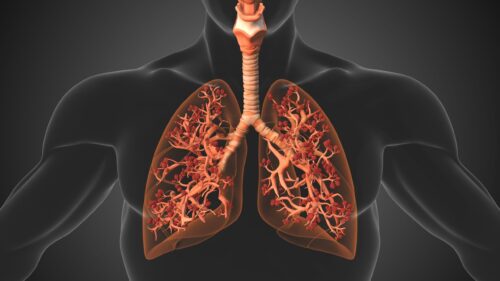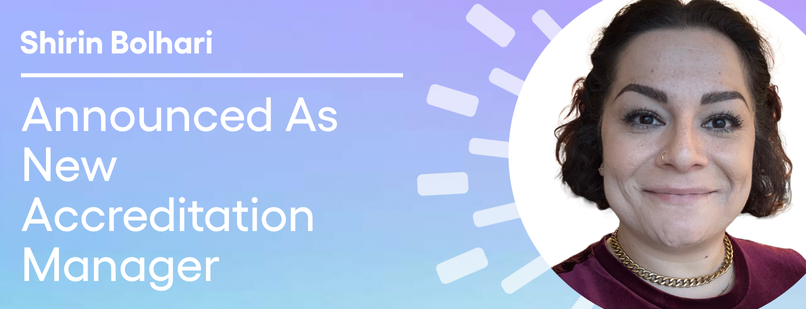
By Debbie Bunch
November 3, 2025
The Jimmy A. Young Medal is awarded each year at the AARC Congress to an individual who has exceeded all expectations for meritorious service to the profession and the patients it serves. It is the highest honor the Association bestows, and its winners include many of the field’s legends.
When AARC members gather for the 2025 Congress in Phoenix next month, they will honor Dianne Lewis, MS, RRT, FAARC, who has dedicated the better part of her life to ensuring the success of not only the AARC but also the respiratory therapists it represents.
Right place, right time, right people
As a former AARC president and the longest-serving member of the AARC Board of Directors (BOD), Dianne has been a key member of the AARC leadership team since the 1980s, when she was first elected to the Board.
But her engagement with the Association dates back even further, to the mid-1970s, when she decided to enter the still relatively new profession of respiratory care.
“Like many individuals, I wanted to pursue a health care career but didn’t know which one,” recalled Lewis. She was at the University of Missouri in Columbia to interview for the physical therapy program when a friend, Bob Stevens, asked her to meet him at the University of Missouri (MU) Medical Center after the interview.
Stevens was enrolled in the respiratory therapy bachelor’s degree program at MU — a member of the second class — and wanted to give her a campus tour and explain what RT had to offer. After taking the tour, Lewis says she was completely intrigued. She immediately contacted the program director to learn how to apply and came face-to-face with one of those RT legends mentioned earlier — James Whitacre.
“He had been a member of the American Association for Inhalation Therapy since 1955 and served on its Board of Directors from 1956-60,” said Lewis. “In 1960, he was involved in the formation of the American Registry for Inhalation Therapy, now the NBRC. He was the first editor of the AAIT journal, Inhalation Therapy, now Respiratory Care. He also later served on the Joint Review Committee for Inhalation Therapy (now CoARC) and was a Jimmy A. Young Medalist.”
Clearly, she was in the right place at the right time, with the right people, to build a career that would lead to her own Jimmy A. Young Medal.
One of just three women
Lewis enrolled in the program and immersed herself in learning how to care for patients with respiratory conditions.
She knew it wasn’t going to be easy. “All my classmates but one had RT experience, and some were already credentialed,” she said. The profession was also male-dominated at the time — she was one of just three women in a graduating class of 12 — and very equipment-oriented.
“Individuals had to be mechanically minded and have the ability to repair and create equipment as needed,” she said. “I actually found it challenging, and I feel my problem-solving skills were developed from my early years in respiratory therapy.”
Lewis graduated cum laude and went to work as an RT at the MU Medical Center, where she says she gained the additional training and experience she needed to pass the Registry exams.
She earned her RRT in 1977 (passing both the written and oral exams). She soon moved up the ladder to evening shift supervisor at MU and then education director at Lester E. Cox Medical Center in Springfield, MO.
In the early 1980s, she moved to Florida and began working at Mount Sinai Medical Center in Miami Beach, where she served in several capacities over the years, including as assistant director of the pulmonary division.
“We had world-renowned physicians with a large research lab,” she explained. When the opportunity to get involved in pulmonary research arose, she jumped at the chance. That led to a published, award-winning paper.
“I was one of two individuals who won the Travenol Literary Award from the AARC in 1984,” she said proudly.
From Miami Beach, Lewis moved to Naples, FL, where she became director of respiratory care services at Naples Community Hospital.
Leading the way
A member of the AARC since her student days (she credits James Whitacre for encouraging her to get involved), Lewis served both the Missouri Society for Respiratory Care and the Florida Society for Respiratory Care in multiple capacities. By the early 1980s, she was taking on leadership roles at the AARC as well.
Lewis served on the AARC House of Delegates (HOD), first as an alternate delegate and later as a delegate, before becoming the HOD treasurer. Then, in 1982, AARC President John Walton, MBA, RRT, FACHE, appointed her to serve on the Program Committee, one of the most important roles in the Association, given the stature of the AARC Congress.
Many other committee assignments followed, but another of her most significant came in 1990, when President Jerome Sulliven, PhD, RRT, FAARC, asked her to be the team leader for one of the groups charged with developing the first Clinical Practice Guidelines (CPGs) for the profession.
“My group, Oxygen Therapy, wrote and published the profession’s first guideline, ‘Oxygen Therapy in an Acute Care Hospital,’ and it was published in Respiratory Care in 1991,” she said.
The CPGs would go on to play a pivotal role in the development of therapist-driven protocols, which, in turn, have increased the value of RTs to their hospitals.
To this day, Lewis counts that first CPG among her most significant professional accomplishments.
Meeting challenges head on
Lewis served as president of the AARC in 1993, where she continued to focus on the CPGs — another 10-12 were published during her term in office — and also marshalled the forces to combat what, at the time, appeared to be a serious threat to the profession.
“During my year as AARC president in 1993, respiratory care departments were being downsized or eliminated, and our duties were being assumed by nursing,” she explained. “One of my goals was ‘Marketing the Respiratory Care Practitioner.’ As part of my plan to do so, I appointed an Ad Hoc Committee on Curriculum Comparison.”
The ad hoc committee was asked to compare respiratory care curricula with those of nursing and other allied health professions to determine the level of training in cardiopulmonary sciences required to provide respiratory care to patients.
The Indiana University Center for Survey Research was hired to assist with the project, and the AARC ultimately showed that most nursing programs provided very little respiratory training, leaving nurses unqualified to perform the duties typically performed by RTs.
The study helped ensure RT departments would remain intact.
Leaping into uncharted waters
Thanks in large part to her leadership roles at the AARC, Lewis became acutely aware of how the profession was expanding into sites beyond the acute care hospital, and she decided to embark on one of those paths less traveled in her professional career as well.
It started by going back to school.
“As I saw the profession expanding and specialty areas becoming a reality, I could see RTs were going to need more education,” she said. “If staff therapists needed more, so did I as a manager and educator.”
Encouraged by her mentors and her employers at the time, she enrolled in the master’s degree program at Florida International University. Upon graduation, she made good on her mission to look outside the acute care hospital and took her new skills into the post-acute care setting.
Lewis began by working with skilled nursing facilities, where she learned more about market analysis, SNF building requirements, and staffing for nurses and RTs. From there, she segued into home care, which she says is one of her favorite areas she has worked in during her career.
She spent the remaining years of her career before retirement working for a variety of post-acute care organizations, helping them develop skilled nursing and home care services for patients in need.
President’s Council service
But how, exactly, did Dianne Lewis end up becoming the longest-serving member of the AARC BOD?
As noted earlier, her service began in the 1980s, when she was elected to the Board as a director. From there, she served a term as BOD secretary, followed by her years as president-elect, president, and immediate past president. She served as the BOD parliamentarian for two other presidents after that.
But most of her service stemmed from her nearly 20-year tenure as chair of the AARC’s Presidents Council.
“It was such an honor to represent this group of leaders,” she said. “All but two are past presidents of the AARC. Eighteen are Jimmy A. Young Medalists and eight are AARC legends. They are from all over the U.S. and volunteered their time over many years to make the profession and the Association a success.”
As chair, Lewis held a non-voting seat on the Board, which gave her a front-row seat to the Association’s inner workings and the debate and discussion that go into making the decisions that drive the profession forward.
“It kept me informed of the current activities of the AARC and important issues that faced the profession,” she said. “I learned as a professional that we are not always going to agree with each other on issues, but we needed to respect each other, our opinions, and work towards common goals.”
She especially loved the opportunity the position gave her to meet and get to know all the new members of the BOD who came along over the years.
“I loved sitting by individuals attending their first meeting,” she said. “I tried to make it informative and share information from my past years of experience as well as provide a historical perspective.”
An honor well deserved
Dianne Lewis has published articles in respiratory journals and delivered presentations to groups and organizations all over the country. She received Life Membership in the AARC in 1994 and became a Fellow of the American Association for Respiratory Care in 2001.
Lewis has witnessed many positive changes in the respiratory care profession over her 50 years in the field, and she has played a significant role in bringing many of those changes to fruition. Receiving the Jimmy A. Young Medal at this year’s AARC Congress is an honor well deserved and one she will always cherish.
“I was so grateful that I was even considered,” she said. “I looked at the individuals who have received the award before me, and I am so very proud to be one of them.”
The Jimmy A. Young Medal recognizes individuals who have an outstanding record of contributions to the AARC vision of professional excellence, advancement of the science and practice of respiratory care, and service as an advocate for patients, their families, the public, the profession, and the respiratory therapist that are well above the usual commitment of time, effort, or material goods. It is the highest honor bestowed by the AARC and is named in honor of AARC President Jimmy A. Young, who died in 1975 after serving the organization for many years.
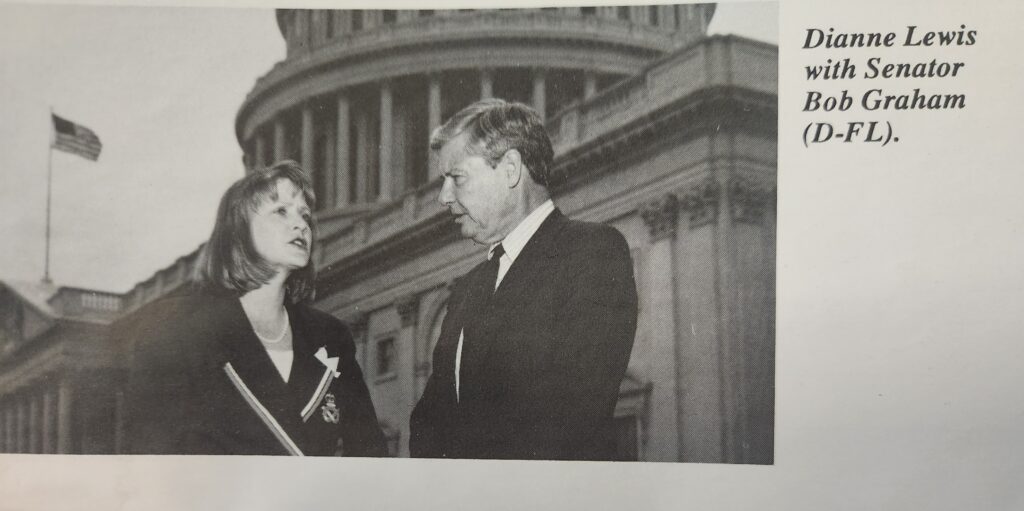
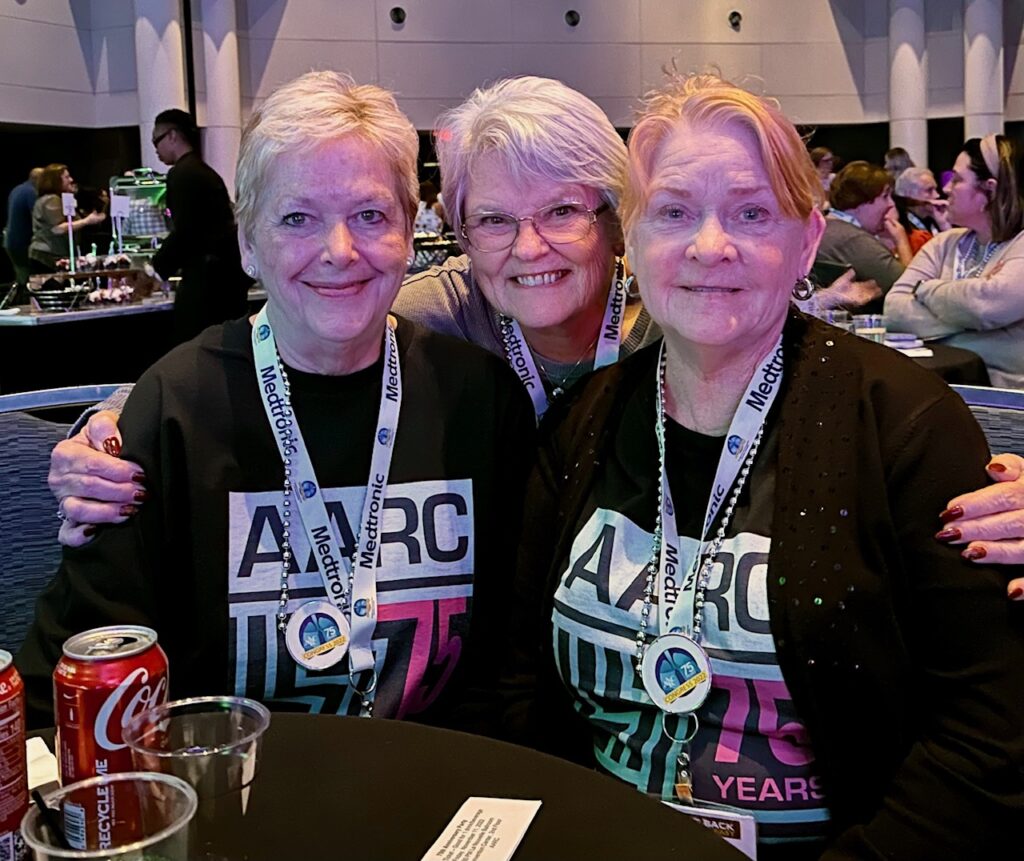

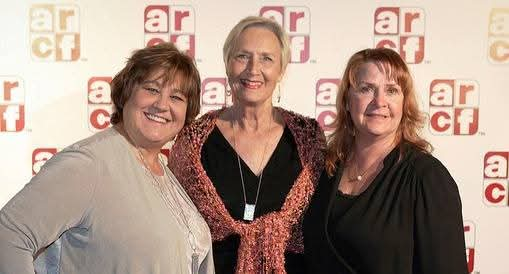
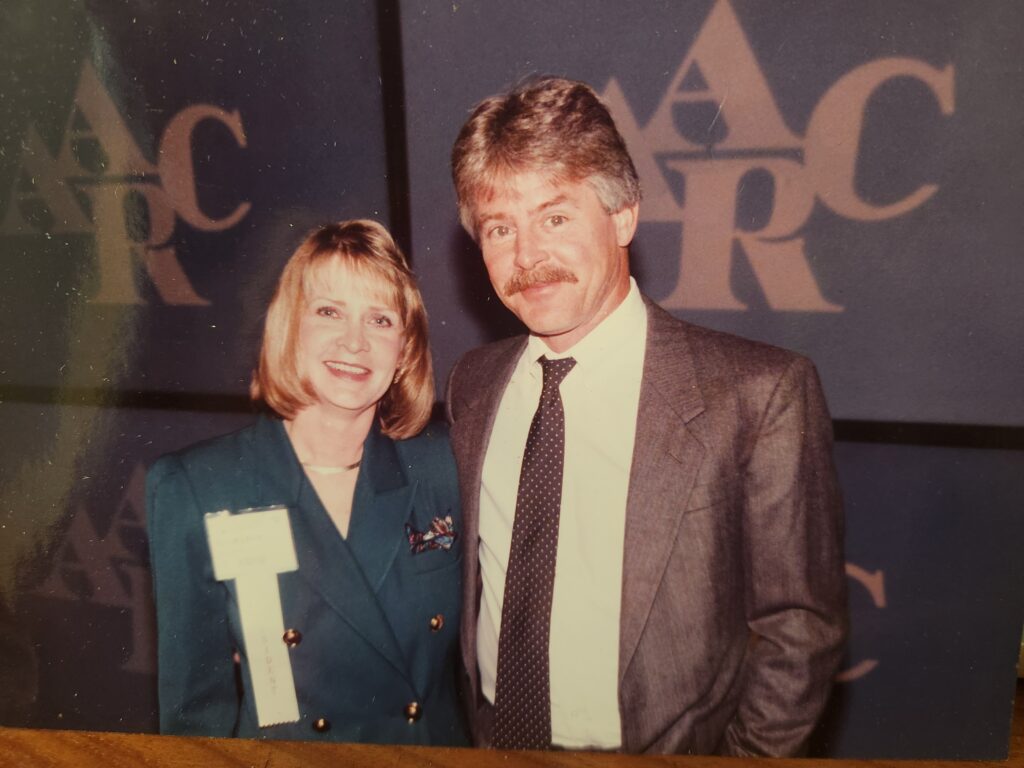
Captions:
Dianne Lewis speaks with Senator Bob Graham (D-FL) at an AARC Capitol Hill event in 1992.
1995 AARC President and AARC Historian Trudy Watson, BS, RRT, FAARC, left, joins AARC 75th Anniversary Committee members Colleen Schabacker, BS, RRT, FAARC, center, and Dianne Lewis, MA, RRT, FAARC, right, at the 75th Anniversary event.
AARC 1993 International Fellows: Lewis, far right, greets the 1993 International Fellows up on stage at the AARC Congress.
Dianne Lewis, right, joined the AARC Associate Executive Director Sherry Milligan, left, and Director of Government Affairs Anne Marie Hummel, center, for a photo op at an ARCF event.
Dianne Lewis and her husband Mike at her swearing-in ceremony when she became AARC president in 1993.




